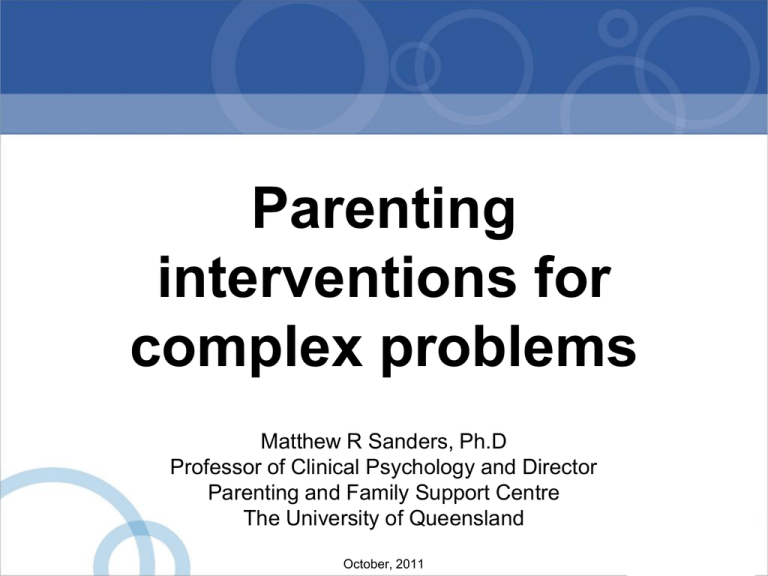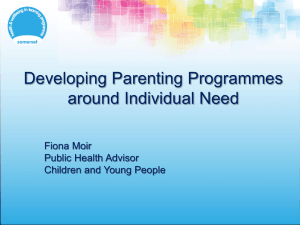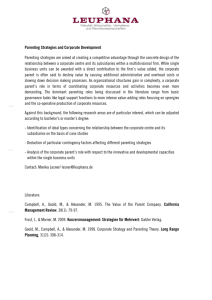Parenting interventions for complex problems
advertisement

Parenting interventions for complex problems Matthew R Sanders, Ph.D Professor of Clinical Psychology and Director Parenting and Family Support Centre The University of Queensland October, 2011 At a glance Role of parenting Parenting interventions with complex problems Challenges ahead Process issues in delivery parenting programs Parental influence is pervasive Language, communication Influences key risk and protective factors Social skills and peer relationships Emotion regulation Physical health and well being Sustained attention and problem solving Coping with adversity and life transitions School achievement Reduced social, emotional and health problems Programs concurrently address multiple problems Child Parent Who benefits Risk of child Depression Parental Depression Disruptive behavior Maltreatment; Parental anger Substance abuse Couple conflict Delinquent behaviors Poor work functioning Better health Better health Parental access has increased • Thousands of practitioners have been trained in evidence-based interventions (e.g. UK, The Netherlands, Belgium, Australia, NZ, Canada, US) • Millions of children and parents worldwide now reap the benefit when programs implemented properly • At the same time there has been a proliferation of NEBP’s • Little work in LMIC’s Information explosion on the webGoogle search “Parenting” yields 209,000,000 hits Media sites Commercial sites Government sponsored sites Social Networking sites Research project sites Apps for smartphones Practitioner sites It’s so confusing to parents Parents want programs that work Focus of parenting support Not a “one size fits all” approach Universal Triple P Level One Selected Triple P Level Two Primary Care Triple P Level three Standard Triple P Level four More complex problems Enhanced Triple P Level five Principles of Positive Parenting Safe, engaging environment Taking care of yourself as a parent Reasonable expectations Positive learning environment Assertive discipline 17 Core Parenting Skills Promoting positive relationships Brief quality time Talking to children Affection Encouraging desirable behaviour Praise, positive attention engaging activities Teaching new skills and behaviours Modelling, Incidental teaching Ask-say-do Behaviour charts Managing misbehaviour Ground rules Directed discussion Planned ignoring Clear, calm instructions Logical consequences Quiet time Time-out Parental Self regulation Selfmanagement Self-efficacy Minimally Sufficient Intervention Personal agency Selfsufficiency Reduced need for support Use Self Regulation Framework How does Triple P stack up? 300 First population level data published 240 Total papers Triple P International begins 200 175 Evaluation studies 150 100 Program development begins Program is given a name 65 Conceptual papers 50 0 1977 1978 1979 1980 1981 1982 1983 1984 1985 1986 1987 1988 1989 1990 1991 1992 1993 1994 1995 1996 1997 1998 1999 2000 2001 2002 2003 2004 2005 2006 2007 2008 2009 2010 2011 No. of published papers 250 271 authors Year The development context 22 million 308 million Many different authors have contributed N = 271 …in different evaluation sites Number of research institutions=59 Number of independent evaluations=61 • • • • • • Australia (University of Queensland, Curtin University, University of Sydney) New Zealand (University of Auckland, Waikato University, University of Canterbury, Victoria University of Wellington) Germany (Technical University of Braunschweig, University of Bielefeld) Scotland (Glasgow Caledonian University, University of Glasgow) England (University of Manchester, Oxford University, Cambridge University, University of East Anglia) US (University of South Carolina, Oregon Research Institute, California State University, University of North Carolina) • • • • • • Belgium (University of Antwerp, University of Brussels) The Netherlands (Trimbos Institute, NjI) Switzerland (University of Fribourg) Canada (University of Manitoba, University of Ottawa, UBC, University of Calgary) Middle East (Medical University of Tehran) Asia (Hong Kong Polytechnic University, University of Tokyo) Plus 13 others Growth of Triple P Training (1996-2011) 4500 Number of training Courses 70000 Number of practitioners trained 4000 60000 3500 50000 3000 2500 2000 40000 PFSC starts 30000 1500 Triple P International starts 20000 1000 10000 500 2011 2010 2009 2008 2007 2006 2005 2004 2003 2002 2001 2000 1999 1998 1997 Slide no.18 1996 0 0 Role of parenting Parenting interventions with complex problems Challenges ahead Types of child problems tackled to date Child maltreatment Conduct problem/ ADHD Recurrent pain syndromes Type of child problem Anxiety Disorders/ Trauma Obesity Feeding disorders Developmental disability Applications to meet the needs of vulnerable parents Separated and divorced couples Indigenous Parents Parents who are offenders Foster Parents Couple in conflict Core Triple P Program Parents with history of domestic violence Parents at risk of abuse Parents of children with special needs Clinically depressed parents Ultimate Outcome Question: Adapted from Paul (1966). Behavior Therapy: Appraisal and Status. McGraw-Hill, NY • What type of intervention works? • For whom? When? and • Under what circumstances? • How does it come about? Strongest evidence relates to early years but parenting continues across the lifespan Weak evidence Transition to parenthood Strongest evidence 3-10 years Parenting of toddlers and preschoolers Parenting of primary school aged children Weaker evidence 11-18 Sandwich/club sandwich generation Parenting of young teenagers Parenting of older teenagers Parenting of young adults no children Grand Parenting/ Great Grand parenting Greatest return on investment 0-3 years Areas of relative neglect Characterizing the type of intervention What works? Triple P is NOT a single program What level of intensity? •Universal •Selected •Primary care •Standard •Enhanced •Full system What mode of delivery? •Individual •Group •Over the Phone •Media based •Web based •Self directed What variant? •Core program •Teen •Stepping Stones •Lifestyle •Resilience •Workplace •Fear-less Characterizing the children and families we serve For whom? What child? •Prematurity •Low birth weight •Developmental disability •Internalising •Externalising •Type and severity of behavior problem What parent? •Depressed •Highly stressed •Unhappy couples •Abusive •Substance abusing •Minority parents •Indigenous •Grandparents •Foster/adoptive What family? • Unhappy couples • Separated/divorced • Incarcerated • Step/blended family • Single parent •Teen parent • Extended family Characterizing Providers and System of Care What delivery system? What provider? •No single discipline delivers Triple P •Government/NGO/ private providers •Web/Self directed What setting? •Home •Clinic (inpatient, outpatient, hospital) •School/Preschool •Child care •At work •Over the phone •Web-based What funding context? •Recurrent funding •Policy setting •Mainstreamed •Prevention or Treatment service •Workplace support Evaluation strategy Phase 1 Building foundations Testing levels of Triple P in isolation Phase 2 Testing multiple levels as a system Phase 3 Improving reach to high need and hard to engage families Mean effect sizes on Child Behavior Outcomes (ECBI Intensity Scores) Based on 29 published RCTs; excludes N=1 studies, quasi experimental, pre-post service based evaluations, or RCT’s under review 1.2 Cohen’s d= .64 1 0.8 0.6 0.4 N=6 N=3 N=1 0.2 N=15 0 Level 2 Level 3 Level 4 Level 5 Sanders, Kirby, Tellegen, & Day (2011). A Meta-Analysis exploring level by level effects for the Triple P-Positive Parenting Program Mean Effects sizes of Parenting Outcomes (PS) 1.2 Cohen’s d= .69 1 0.8 0.6 0.4 0.2 0 Level 2 Level 3 Level 4 Level 5 Sanders, Kirby, Tellegen, & Day (2011). A Meta-Analysis exploring level by level effects for the Triple P-Positive Parenting Program: Preliminary Findings. Some important milestones Themes guiding our work Increased consumer or end user focus Strengthening the public health approach Concurrent targeting of breadth and intensity Adapting and tailoring to needs of high risk families Building a stronger workforce Increased enduser or consumer focus Under what circumstances? Discrimination Refugee status Parental mental health Enablers & barriers Acculturation Parental concern about child behavior Perceived vulnerability Severity of child problem Level of parental distress Family friendly policies Poverty Employment status Type of Neighborhood Motivation Program itself Perceived need Anticipated benefits/costs Available incentives Competing demands Type of message Provider ethnicity/skills Cost/Accessibility Program format Cultural Acceptability Social infrastructure Outcomes Cognitions or Affect Social influence In home support Extended family support, Community and neighborhood support Expectation of benefit Parental self-efficacy Access to role models Parental attributions Gender/age of parent Prior help seeking Level of violence Family of origin experiences Immigration status Culturally normative parenting practices Available parenting services Connectedness to community Education /literacy Laws Ensure our programs are culturally acceptable Minority, refugee, or indigenous parents are less likely to participate Adopting an end-user perspective helps to… Tailor content to needs and aspirations of target group Optimize program delivery Improve engagement Enablers & barriers Parental concern about child’s behavior Perceived vulnerability Severity of child problem Level of parental distress or anxiety Program variables Motivational variables Perceived need Anticipated benefits/costs Incentives Competing demands Engagement Message Providers-ethnicity, experience, skills Cost/ accessibility Program format Acceptability of parenting advice Cognitive/ Affective variables Social influence Variables Expectancies of benefit Parental self efficacy Access to models In home support Extended family support, Community and neighborhood support Parental attributions 10 9 8 7 6 5 4 3 2 1 0 Time Out Quiet Time Logical… Giving Instructions Planned Ignoring Directed Discussion Ground Rules Behaviour Charts Ask, Say, Do Incidental Teaching Set a Good… Engaging Activities Attention Praise Show Affection Talking with child Quality Time Usefulness Minority parents and professionals views on cultural appropriateness Practitioner Parent Tailoring to needs of parents Grandparents Foster parents Using epidemiology and qualitative methods to tailor program to needs Working parents Parents of children with CP Parents of multiples Parents of children with ASD Tailoring content or process (as needed) Testing efficacy of adapted version Consumer input Research Program modification Grandparent Triple P (Kirby & Sanders, in prep) Consumer Input through focus groups Research Arguments over parenting “There are arguments around discipline, about how we as grandparents treat the grandkids I suppose versus how the parents do it.” Concerns over grandparent role taking “I just get the feeling that sometimes my son is starting to take me a little bit more for granted. And that becomes overwhelming and frustrating.” Parents dislike unsolicited parenting advice from own parents (Thomas, 1990) Grandparents report finding the role exhausting and demanding (Fitzpatrick & Reeve, 2003) Program Modification Inclusion of module centered on effective communication skills and problem solving Session 4: How to build a positive parenting team (e.g., dealing with emotional distress, page 88) Inclusion of strategies to manage emotional distress Session 5: Grandparent survival skills (e.g., Exercise 6 ways to look after yourself, page 108) Tailoring Process Knowledge gained from consumers Research evidence Tailored variant ready for empirical testing Using more intensive individual and group programs with vulnerable families Why focus on parental attributions • An attribution is a causal explanation individuals use to explain events that occur to them. • Parents at risk of child maltreatment are more likely to blame their child for the child’s misbehaviour. • Parents’ misattributions for children’s behaviour can lead to poor parent-child attachment and an increased risk of child maltreatment. What is Pathways Triple P? • A Level 5 intervention • additional modules, 2 sessions in each module – – Module 1: Attribution retraining (2 hours) Avoiding parent traps Module 2: Anger management (2 hours) - Coping with anger plus – Module 3: Maintenance and closure (2 hours) Pathways Triple P Delivery Options Intake interview 1 individual session Group Triple P 4 group sessions Standard Triple P 6 individual sessions Pathways Triple P Module 1 and 2 4 group sessions Pathways Triple P Module 1 and 2 4 individual sessions Closure session 1 group session Closure session 1 individual session Main findings Sanders, Pidgeon et al (2004) Both conditions showed significant improvements over time on all key outcome measures • Observed disruptive behavior (FOS) • Disruptive child behaviour (ECBI scores) • Parental anger (PAI and STAXI) • Dysfunctional discipline (Parenting Scale) Pathways Triple P showed additive benefits on the following measures • Lower dysfunctional parent expectations (POQ) • Lower child abuse potential (CAPI abuse scale) • Less dysfunctional attributions for own behaviour • Less dysfunctional attributions for child’s behaviour Positive Parenting after separation or divorce Relationship breakdown • Relationship breakdown is a major life stressor for parents, children, and their extended families • Although declining 40% of all marriages end in divorce1 • Half of all divorces involve parents • Divorce impacts on 44, 000 Australian children each year. Source: Australian Bureau of Statistics (2007). Divorces Australia. Canberra, Australia. Program Content • • • • • 12 week program Divorce – a Family Transition Coping with Emotions Managing Conflict Balancing work, family, and play Positive Parenting Outcomes ↓ Fewer behavioural and emotional problems ↓Dysfunctional parenting practices ↓Parental Expressed and Trait Anger Parents of children who are bullied Bullying Anxiety Loss of friendships Behaviour problems Suicide School bullying has severe consequences Health problems Lower self-esteem Depression School absenteeism Increased long-term risk of severe mental health problems, school dropout, involvement in criminal justice system What is Facilitative Parenting? Talks to child about issues Facilitative Parenting Enjoys child’s company Facilitates peer interaction Communicates well with child’s teacher Helps child resolve conflicts Not aggressive to others in defense of child Avoids over protectiveness Encourages appropriate independence Resilience Triple P Facilitative parent training LESS Peer Victimisation Social and emotional skills for children Australian Research Council funded RCT under way Role of parenting Parenting interventions with complex problems Challenges ahead Need responsive program delivery Flexibility vs fidelity Content variations Low risk Process variations High risk Low risk High Risk Mazzucchelli, T. & Sanders, M.R. (2010). Facilitating Practitioner Flexibility Within an Empirically Supported Intervention: Lessons From a System of Parenting Support. Clinical Psychology Research and Practice, 17, 238-252. Process Variations Low Risk More sessions High Risk Advice to use or not to use specific strategies Session length Session location No agenda or session structuring School contact No review of homework Switch to briefer version Repeated abandoning of agenda Individual prep before group Always proving answers More emphasis on practice and DVD Giving feedback without Content Variations Low Risk Modify examples to make more relevant to target group High Risk Withholding information about certain strategies Modify steps from a tipsheet in a Suggest parent stray from parenting plan principles underlying the recommended parenting Changing focus of session to strategy partner support Combining a selection of Triple P strategies with programs Triple P keeps evolving Work in progress More Intensive Less intensive Population level Other Taking Care Triple P for foster carers Lifestyle Triple P Seminar seriesPositive Parenting for Healthy Living (Obesity prevention) Stepping Stones as a public health intervention for children with a disability PASS model of supervision trial Group Triple P for children with language delay Workplace Triple P (EAP) Emotion-focused Group Triple P for children with disruptive Brief 4 session online behaviour problems Primary Care intervention Triple P for teachers Seminar series and child care (Prevention of CD) providers Pathways Group Triple P for offenders International Triple P Research Network • Complex problems don’t always require complex solutions • Parenting programs can be effectively applied to a wide range of clinical problems in children and young people • Parenting programs are also useful with a diverse range of adults including those with serious mental health problems • Benefits are typically intergenerational A final word Significant investment in parenting programs makes good sense. Parenting programs can be tailored to a wide range of disorders and problem behaviors Thank you for your attention For further information on Triple P Research: www.pfsc.uq.edu.au Training and materials: www.triplep.net


